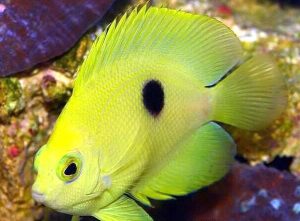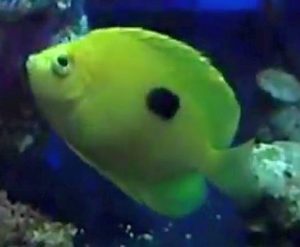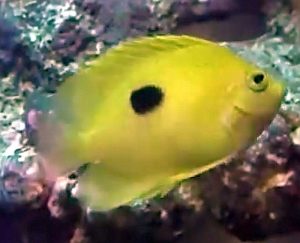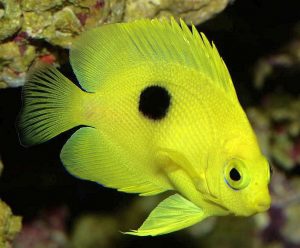The Narcosis Angelfish (Centropyge narcosis) known to tropical fish keeping enthusiasts as the Narc Angelfish or Deep Reef Pygmy Angel is an elusive deepwater species found in the Eastern Central Pacific Ocean of Rarotonga, Cooks Islands and more recently discovered over 700 miles away in the deep waters of Tahiti.
The Narcosis Angelfish is closely related to Colin’s Angelfish (Centropyge colini) in form and behavior, and is found singly or in small groups at depths from 360 to over 420 feet.
Like Colin’s Angelfish, the Narcosis Angelfish is a shy, reclusive species that prefer living among rocky vertical drop offs in caves, overhangs, and crevices where they can easily hide when threatened. They are frequently observed swimming upside down with their bellies tight to the ceiling of a cave or overhang.
They will often hang in a head down position with their dorsal spines extended to ward off larger predators. The black dots flanking their sides apparently look like large eyes to fish eating predators.
The first known Narcosis Angelfish ever collected was by Richard Pyle around the Cook Islands at a depth of 330 to 340 feet.
Narcosis Angelfish (Centropyge narcosis) have a strikingly bright yellow body color with a single jet black spot on either side of the fish, a tall body profile, and prominent dorsal fin spikes that are quite sharp. Males are believed to be slightly larger than females and cannot be distinguished by color.
In the unlikely event you are able to acquire a Narcosis Angelfish, they are best housed in a well established deepwater reef aquarium of at least a 70 gallon capacity with a variety of large polyp stony corals, a few deepwater Acropora species, and plenty of live rock arranged into caves, overhangs, and crevices for them to hide and graze upon.
The lighting in the tank should be dimmed to replicate their deepwater habitat and a chiller is required to keep the maximum temperature in the tank under 74° Fahrenheit. These reclusive angelfish require very stable water conditions and pristine water quality. Once acclimated, at least monthly 20-30% water changes are recommended.
Narcosis Angelfish can be housed with other non threatening tankmates such as Snowflake Clownfish, small wrasses, gobies, blennies, Scarlet Cleaner Shrimp, etc. As long as they are the dominant fish in the tank and plenty of live rockwork arranged into overhangs and caves is provided, other peaceful deepwater angelfish can also be safely kept with Centropyge narcosis.
Because Narcosis Angelfish have a fondness for sessile corals such as some Fungiids species like Cycloseris and Fungia, and some Chalice Corals like Echinophyllia, Echinopora, and Mycedium; they are not considered reef safe. However, when well fed, infrequent nipping on healthy Chalice corals is not usually detrimental. Fungiids however take longer to recover.
Although Narcosis Angelfish have not been bred in an aquarium environment, they are believed to be pelagic spawners that in their
natural habitat form pairs or have small harems of 3 to 7 individuals. Males will usually spawn with individual females at dusk. The pair rise up into the water column where the male encourages the female to release her eggs. The pair join belly to belly and their eggs and sperm are released into the water column. The eggs rise toward the surface where they become part of the plankton chain and receive no parental care.
Narcosis Angelfish are omnivores and although their natural diet is unknown, they will accept a wide range of angelfish foods. They need substantial quantities of mature live rock in their tank to graze upon in addition to a variety of fresh and frozen Mysis shrimp, brine shrimp, Krill, Cyclops, meaty crustaceans like clams or shrimp, and commercially prepared foods enriched with marine algae, sponges, and spirulina.
They do well on frozen Angel Formula and Formula II once acclimated and should be fed at least 2 to 3 times a day. The challenge to maintaining this species is to first get the fish acclimated and then keep it interested in eating food. Keeping the aquarium lighting low during feeding sessions will help avoid startling the fish.
Like all deepwater species, Narcosis Angelfish (Centropyge narcosis) are incredibly rare to tropical fish keeping enthusiasts and when available fetch huge sums of money. The Narcosis Angelfish is more expensive than the Peppermint Angelfish (Centropyge boylei). Both of these “twilight” species have sold for five figures or more. A specimen in 2012 sold for a bargin price of $4,999.00 and was snatched up in seconds. Most rare deepwater species are sold directly to the Asian market where they realize top dollars from aquariums and rare tropical fish collectors.
Minimum Tank Size: 70 gallons
Aquarium Type: Deepwater Reef
Care Level: Difficult
Temperament: Peaceful
Aquarium Hardiness: Difficult to acclimate
Water Conditions: 72-74°F, dKH 8 to 12 , pH 8.1 – 8.4, sg 1.023-1.025
Max. Size: 3.5″
Color Form: Yellow, Black
Diet: Omnivore
Compatibility: Reef w/Caution
Origin: Cook Islands, Tahiti
Family: Pomacanthidae
Lifespan: 5-7 years
Aquarist Experience Level: Expert






One Response to “Narcosis Angelfish (Centropyge narcosis)”
Trackbacks/Pingbacks
[…] most rare deep water species like Centropyge narcosis, Centropyge nahackyi, Centropyge hotumatua, etc. are sold directly to tropical fish keeping […]